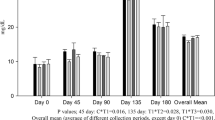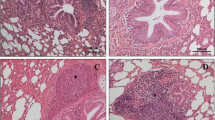Abstract
The aim of this study was to compare hematological, some biochemical parameters, and serum trace element concentrations in horses with or without pica. Fifteen horses with pica (group I) and another 15 healthy horses without pica (group II) were used. The hematological parameters were not changed between the two groups. In group I, hemoglobin values were lower than those of group II. However, the difference in hemoglobin values between the two groups was not significant (P > 0.05). Serum iron and copper concentrations and the copper/zinc ratio were lower in group I than those of group II (P < 0.05). The other biochemical parameters were not found to be statistically different between the two groups (P > 0.05). It was concluded that serum iron and copper deficiency may play an important role for the etiology of pica in horses. Prophylactic use of iron and copper supplements in horses may be beneficial to prevent pica.
Similar content being viewed by others
References
Maas J (2002) Alterations in body weight or size. In: Smith BP (ed) Large animal internal medicine, 3rd edn. Mosby Inc, St Louis, p 170
Ralston SL (1986) Feeding behavior. Vet Clin North Am Equine Pract 2(3):609–621
Jain RK, Chopra RC (1994) Effect of feeding low phosphorus diet of feed intake, nutrient utilization, growth and certain blood parameters in calves. Indian J Anim Nutrition 11(4):205–210
Ghergariu S, Bale G, Musca M, Kadar L (1994) Epidemiological, clinical and biochemical features of blood and urine in cattle Inan area of enzootic osteomalacia. Re Rom Med Vet 4(1):37–47
Smith JW, Adebowale EA, Ogundola FI, Taiwo AA, Akpavie SO, Larbi A, Jabbar MA (2000) Influence of minerals on the etiology of geophagia in periurban dairy cattle in the derived savannah of Nigeria. Trop Anim Hlth Prod 32(5):315–327
Ranjhan SK, Pathak NN (1992) Nutritional and metabolic disorders of buffaloes. In: Tulloh NM, Holmes JHG (eds) Buffalo production. World Animal Science, Elsevier, Amsterdam, pp 355–374
Singh KP, Malik KS, Sarup S (1986) Haemato-biochemical studies in camel suffering from pica. Indian J Vet Med 6(2):79–81
Sahin T, Cimtay I, Aksoy G (2001) Investigations on some biochemical parameters in lambs with pica and in healthy lambs. Turk J Vet Anim Sci 25:603–606
Akgul Y, Agaoglu ZT, Kaya A, Salin T (2000) The relationship between the syndromes of wool eating and alopecia in Akkaraman and Morkaraman sheep fed corn silage and blood changes (haematological, biochemical and trace elements). Israel J Vet Med 56(1):23–37
McGreevy PD, Hawson LA, Habermann TC, Cattle SR (2001) Geophagia in horses: a short note on 13 cases. Appl Anim Behav Sci 71:119–125
Husted L, Andersen MS, Borgaard OK, Houe H, Olsen SN (2005) Risk factors for faecal sand excretion in Icelandic horses. Equine Vet J 37:351–355
Lucio WF, Roberts ED, Adams LG, Gallo JT, Sanchez O (1972) Patologia de las Deficiencias de Calcio y Fosforo en Cerdos: Arquivos da Escola de Veterinaria Universidade Federal de Minas Gerais 24(2):137–152
Firyal S (2007) Pica (depraved appetite; allotrophagia) in domestic animals and man. Pakistan Vet J 27(4):208–210
Bertone JJ, Traub-Dargatz JL, Wrigley RW, Bennett DG, Williams RJ (1988) Diarrhea associated with sand in the gastrointestinal tract of horses. J Am Vet Med Assoc 193:1409–1412
Blood DC, Radostits OM (1989) Veterinary medicine a textbook of the diseases of cattle, sheep, pigs, goats and horses, 7th edn. Bailliere Tindall, London, p 180
Rosenberger G (1994) Krankheiten des Rindes. Blackwell Wissenschafts Verlag, Berlin, pp 173–351
Whitlock RH, Kessler MJ, Tasker JB (1975) Salt (sodium) deficiency in dairy cattle: polyuria and polydipsia as prominent clinical features. Cornell Vet 65(4):512–526
Fahmy F, Amer AA, Abd-el-Aziz H, Abd-el-Roaf M (1980) Wool as an effective tool of some deficiency diseases. Assiut Vet Med J 7(13/14):262–270
Meyer H, Lohse K (2002) Ca and P supply of ruminants in the 19th and beginning of 20th century in Middle Europe. Dtsh Tierarztl Wochenschr 109(1):34–37
Arbiter EA, Black D (1991) Pica and iron-deficiency anemia. Child Care Health Dev 17:231–234
Stein DJ, Bouwer C, van Heerden B (1996) Pica and the obsessivecompulsive spectrum disorders. S Afr Med J 86(12):1586–1588
Kraft W, Dürr UM (2005) Klinische Labordiagnostik in der Tiermedizin, 6th edn. F.K. Schattauer Verlagsgesellschaft mbH, Stuttgart
Suliman HB, Abdelrahim AI, Zakia AM, Shommein AM (1988) Zinc deficiency in sheep: field cases. Trop Anim Health Pro 20(1):47–51
Knottenbelt DC, Pascoe RR (2003) Diseases and disorders of the horse, 3rd edn. Harcourt Publishers, Spain, pp 180–202
Hyslop NSG (1977) Pica in man and animals. Br J Haematol 37(1):154–155
Rosen AC, Rosen HR, Huber K, Bauer K, Ausch C, Redlich K, Klein MJ, Moroz C (1995) Correlation of placental isoferritin with birth weight and time point of first contractions. Gynecol Obstet Invest 39:11–14
Haris ZL, Takahashi Y, Miyajima H, Serizawa M, Mac-Gillivray RTA, Gitlin JD (1995) Aceruloplasminemia: molecular characterization of a novel disorder of iron metabolism. Proc Natl Acad Sci 92:2539–2543
Arbiter EA, Black D (1991) Pica and iron-deficiency anemia. Child Care Hlth Dev 17:231–234
Fairbanks VF, Beutler E (1991) Iron deficiency. In: Williams WJ, Beutler E, Erslev AJ, Lichtman MA (eds) Hematology, 4th edn. McGraw-Hill Publishing Co, New York, pp 482–505
Korman SH (1990) Pica as a presenting symptom in childhood celiac disease. Am J Clin Nutr 51:139–141
Author information
Authors and Affiliations
Corresponding author
Rights and permissions
About this article
Cite this article
Aytekin, I., Onmaz, A.C., Aypak, S.U. et al. Changes in Serum Mineral Concentrations, Biochemical and Hematological Parameters in Horses with Pica. Biol Trace Elem Res 139, 301–307 (2011). https://doi.org/10.1007/s12011-010-8660-y
Received:
Accepted:
Published:
Issue Date:
DOI: https://doi.org/10.1007/s12011-010-8660-y




